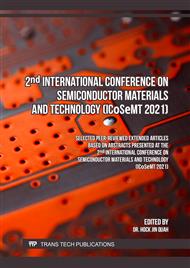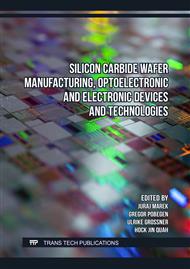[1]
D. A. Neamen, Semiconductor Physics and Devices, Fourth. University of New Mexico: McGraw-Hill Education, 2003.
Google Scholar
[2]
P. Kondaiah, V. Madhavi, S. Uthanna, K. A. Kumar, and W. Vandervorst, "Structural and electrical characterization of Al/ZrO2/Si capacitors," 2012 Int. Conf. Emerg. Electron. ICEE 2012, p.5–8, 2012.
DOI: 10.1109/icemelec.2012.6636248
Google Scholar
[3]
C. D. Young et al., "Effect of dielectric thickness and annealing on threshold voltage instability of low temperature deposited high-k oxides on ZnO TFTs," IEEE Int. Integr. Reliab. Work. Final Rep., vol. 2016-March, p.34–36, 2016.
DOI: 10.1109/iirw.2015.7437062
Google Scholar
[4]
A. Kumar, "Leakage Current Controlling Mechanism Using High K Dielectric + Metal Gate," Int. J. Inf. Technol. Knowl., vol. 5, no. 1, p.191–194, 2012.
Google Scholar
[5]
C. H. Choi et al., "C-V and gate tunneling current characterization of ultra-thin gate oxide MOS (tox=1.3-1.8 nm)," Dig. Tech. Pap. - Symp. VLSI Technol., p.63–64, 1999.
Google Scholar
[6]
K. H. Lee, S. Bao, G. Y. Chong, Y. H. Tan, E. A. Fitzgerald, and C. S. Tan, "Fabrication and characterization of germanium-on-insulator through epitaxy, bonding, and layer transfer," J. Appl. Phys., vol. 116, no. 10, p.1–6, 2014.
DOI: 10.1063/1.4895487
Google Scholar
[7]
H. J. O. Y. Barnscheidt, J. Schmidt, G. Wetzel, D. Tetzlaff, T. F. Wietler, "Highly boron-doped germanium layers on Si(001) grown by carbon-mediated epitaxy," J. Phys. D Appl. Phys., no. 001, p. https://doi.org/10.1088/1361-6463/aad7de, 2018.
DOI: 10.1088/1361-6641/aade69
Google Scholar
[8]
P. S. Goley and M. K. Hudait, "Germanium based field-effect transistors: Challenges and opportunities," Materials (Basel)., vol. 7, no. 3, p.2301–2339, 2014.
DOI: 10.3390/ma7032301
Google Scholar
[9]
S. Hlali, N. Hizem, and A. Kalboussi, "Investigation of capacitance characteristics in metal/high-k semiconductor devices at different parameters and with and without interface state density (traps)," Bull. Mater. Sci., vol. 40, no. 5, p.1035–1041, 2017.
DOI: 10.1007/s12034-017-1443-8
Google Scholar
[10]
R. Zhang, Q. Zhang, X. Zhou, Y. Zhu, X. Ming, and N. Gao, "Design and Fabrication of the Silicon-based Integrated MIM Capacitors," in Proceedings - 2018 19th International Conference on Electronic Packaging Technology, ICEPT 2018, 2018, p.4.
DOI: 10.1109/icept.2018.8480590
Google Scholar
[11]
S. K. Pradhan, E. K. Tanyi, J. R. Skuza, B. Xiao, and A. K. Pradhan, " Electrical behavior of atomic layer deposited high quality SiO 2 gate dielectric ," J. Vac. Sci. Technol. A Vacuum, Surfaces, Film., vol. 33, no. 1, p. 01A107, 2015.
DOI: 10.1116/1.4905778
Google Scholar
[12]
S. Kaya, R. Lok, A. Aktag, J. Seidel, and E. Yilmaz, "Frequency dependent electrical characteristics of BiFeO3 MOS capacitors," J. Alloys Compd., vol. 583, p.476–480, 2014.
DOI: 10.1016/j.jallcom.2013.08.204
Google Scholar
[13]
A. Afshar, T. Muneshwar, K. Cadien, G. Shoute, and D. Barlage, "Sustained hole inversion layer in a wide-bandgap metal-oxide semiconductor with enhanced tunnel current," Nat. Commun., p.1–5, 2016.
DOI: 10.1038/ncomms10632
Google Scholar
[14]
S. Hlali, N. Hizem, and A. Kalboussi, "Investigation of capacitance characteristics in metal/high-k semiconductor devices at different parameters and with and without interface state density (traps)," Bull. Mater. Sci., vol. 40, no. 5, p.1035–1041, 2017.
DOI: 10.1007/s12034-017-1443-8
Google Scholar
[15]
Sema Turkay, and Adam Tatroglu, "Complex dielectric permittivity, electric modulus and electrical conductivity analysis of Au/Si3N4/p-GaAs (MOS) capacitor," J. Mater Sci: Materials in Electronics, vol. 32, no. 5, pp.11418-11425, 2021.
DOI: 10.1007/s10854-021-05349-z
Google Scholar
[16]
Zhexi Xiao, Chao Lei, Chunhui Yu, Xiao Chen, Zhenxing Zhu, Hairong Jiang and Fei Wei, "Si@Si3N4@C composite with egg-like structure as high-performance anode material for lithium ion batteries," Energy Storage Materials, vol.24, pp.565-573,2020.
DOI: 10.1016/j.ensm.2019.06.031
Google Scholar
[17]
K.Muthuseenu, H.J. Barnaby, A. Patadia, K. Holbert and A. Privat, "Ionizing radiation tolerance of stacked Si3N4-SiO2 gate insulators MOSFET," Microelectronics Reliability, vol.104, pp.113554-113559,2020.
DOI: 10.1016/j.microrel.2019.113554
Google Scholar
[18]
V.A.K Raparla, S.C. Lee, R.D. Schrimpf, D.M. Fleetwood and K.F. Galloway, "A model of radiation effects in nitride-oxide film for power MOSFET applications," Solid State Electronics, vol.47, pp.775-783,2003.
DOI: 10.1016/s0038-1101(02)00375-1
Google Scholar



